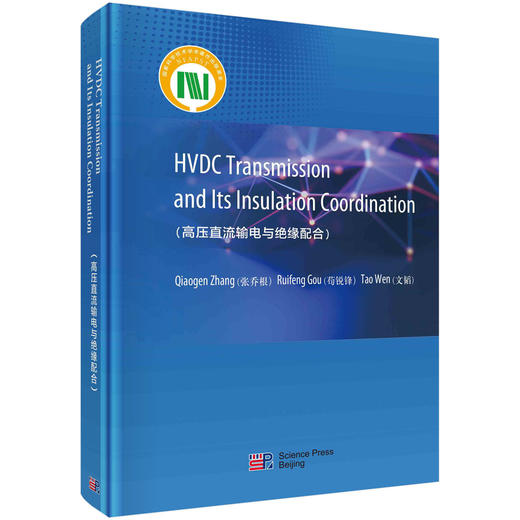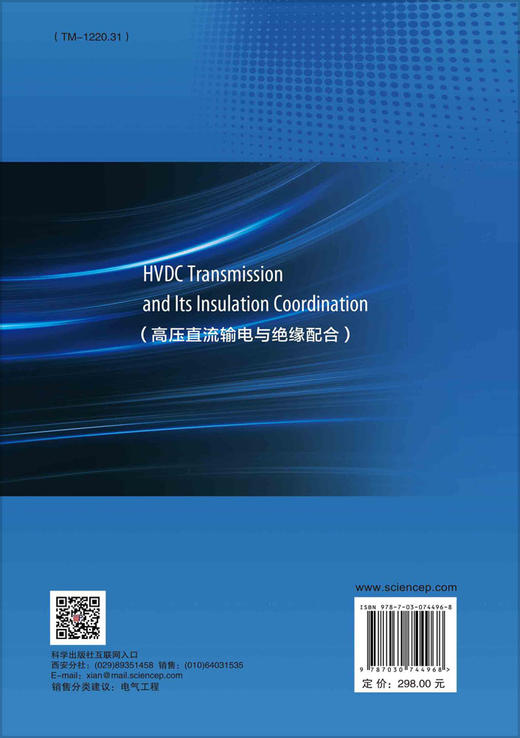HVDC Transmission and Its Insulation Coordination
¥235.40
| 运费: | ¥ 0.00-18.00 |
商品详情
书名:HVDC Transmission and Its Insulation Coordination
定价:298.0
ISBN:9787030744968
作者:张乔根,苟锐锋,文韬
版次:1
出版时间:2023-10
内容提要:
本书总结了作者团队在高压直流输电系统过电压与绝缘配合方面的研究成果和工程经验。全书共7章,主要内容包括:高压直流输电系统概述、晶闸管换流技术与换流站配置、直流系统运行特性与故障分析、高压直流换流站的暂时与操作过电压、高压直流换流站雷电与陡波过电压、高压直流换流站绝缘配合方法、高压直流换流站避雷器配置。
目录:
Contents
Chapter 1 Overview of HVDC Transmission System 1
1.1 Overview of the Development of HVDC Transmission Technology.1
1.2 Technical Characteristics of HVDC Transmission 2
1.2.1 Advantages of HVDC Transmission 3
1.2.2 Disadvantages of HVDC Transmission 4
1.3 Structure of HVDC Transmission System.6
1.3.1 Two-Terminal HVDC Transmission 7
1.3.2 Monopolar DC Transmission 9
1.3.3 Bipolar System 11
1.3.4 Back-to-Back DC System 14
1.3.5 Multi-Terminal DC System 16
Chapter 2 Thyristor-Based Conversion and Configuration of Converter Station.20
2.1 Thyristor 20
2.1.1 Thyristor Structure 20
2.1.2 Dynamic Characteristics of Thyristor 21
2.1.3 Trigger of Thyristor 23
2.1.4 Thyristors in Series 24
2.2 Thyristor Commutation Technology 26
2.2.1 Line-Commutated Converters 26
2.2.2 Analysis of Six-Pulse Rectifier 27
2.2.3 Analysis of Six-Pulse Inverter 31
2.2.4 DC Voltage of Six-Pulse Converter 33
2.2.5 DC Voltage of Twelve-Pulse Converter40
2.3 Composition and Arrangement of Converter Station 45
2.4 Equipment in Converter Station.49
2.4.1 Converter Valve 49
2.4.2 Converter Transformer 52
2.4.3 Smoothing Reactor 56
2.4.4 AC Filter 59
2.4.5 DC Filter 61
2.4.6 Reactive Power Compensation 63
2.4.7 Other Equipments 65
2.5 Main Connection of Converter Station 66
2.5.1 Wiring of Converters 66
2.5.2 Connection Between the Converter Transformer and the Converter Valves 67
2.5.3 AC Filter Access System 69
2.5.4 DC Switchyard Wiring 71
2.6 Converter Control Mode and Configuration 73
2.6.1 Converter Control Mode73
2.6.2 Converter Control Configuration 76
2.6.3 Controller Model of Converter 81
Chapter 3 Operating Characteristics and Fault Analysis of DC System 88
3.1 Steady-State Operating Characteristics of DC System 88
3.1.1 Operating External Characteristics of DC System88
3.1.2 Power Characteristics of Converter 94
3.1.3 Harmonic Characteristics of Converter.101
3.2 Reactive Power Balance in DC System 110
3.3 Operation Mode of DC Transmission System 113
3.3.1 Operation Wiring Mode 114
3.3.2 Full-Voltage Operation and Reduced-Voltage Operation 119
3.3.3 Power Forward and Reverse Transmission Mode 120
3.3.4 Bipolar Symmetry and Asymmetry Operation Mode 120
3.4 Failure Analysis of DC Transmission System 124
3.4.1 Converter Failure 124
3.4.2 Fault on DC Side of Converter Station 136
3.4.3 Fault on AC Side of Converter Station.137
3.4.4 HVDC Line Fault and Grounding Electrode Fault 146
Chapter 4 Temporary and Switching Overvoltages in HVDC Converter Station 149
4.1 Overvoltage from AC Side of the Converter Station 149
4.1.1 Ground Fault on AC Side151
4.1.2 Clearing of Ground Fault on AC Side.154
4.1.3 Switching of Converter Transformer 157
4.1.4 Operating Lines on AC Side 161
4.1.5 Operating Filters at Converter Station 1…
4.1.6 Overvoltage at Load Rejection 165
4.2 Overvoltage from DC Side of the Converter Station 167
4.2.1 Commissioning or Decommissioning of Twelve Pulse Converter 167
4.2.2 Short Circuit to Ground on Valve Side of Converter Transformer 168
4.2.3 Overvoltage Generated on the Converter Valve Bridge 174
4.2.4 Ground Fault on DC Side Line.176
4.3 Losing of AC Power on the Inverter Side 180
4.4 Commutation Failure 182
4.4.1 Analysis of Commutation Failure Process 182
4.4.2 Reactive Power Fluctuation Caused by Commutation Failure 185
4.4.3 Transient Overvoltage Characteristics Caused by Commutation Failure191
4.4.4 Influence of Control System Parameters on Overvoltage Caused by Commutation Failure 193
4.5 Fault on Neutral Bus204
4.6 Open Circuit Fault on Grounding Electrode Lead 206
Chapter 5 Lightning and Steep Front Overvoltage in HVDC Converter Station 208
5.1 Lightning Simulation.208
5.1.1 Types of Lightning Stroke 208
5.1.2 Lightning Current 209
5.1.3 Lightning Stroke Density and Point 212
5.2 Lightning Overvoltage on AC Side 212
5.2.1 Lightning Overvoltage due to Shielding Failure 213
5.2.2 Lightning Overvoltage of Return Stroke 214
5.2.3 Induced Lightning Overvoltage.218
5.2.4 Lightning Intrusive Surge.219
5.3 Shielding Failure in AC and DC Switchyards 220
5.4 Lightning Overvoltage on Line of DC Side 224
5.4.1 Computation Models224
5.4.2 Lightning Overvoltage of Shielding Failure on Line of DC Side.228
5.4.3 Return Stroke Overvoltage on Line on the DC Side 231
5.5 Steep Front Surge.234
5.5.1 Short Circuit or Flashover to Earth235
5.5.2 All Turned-on of Converter Valves and Mis-operation of Bypass Pair in Part of Converters.237
5.6 Simulation Model and Research Method of Overvoltage 238
5.6.1 System Simulation Model 238
5.6.2 Research Methods for Determination of Overvoltage 242
Chapter 6 Insulation Coordination Method for HVDC Converter Station 245
6.1 Principles and Methods of Insulation Coordination 245
6.1.1 Principles of Insulation Coordination 245
6.1.2 Methods of Insulation Coordination 246
6.2 Active Insulation Coordination Procedure 248
6.2.1 Equipment Layout of Converter Station 248
6.2.2 Active Coordination of Control Protection System 253
6.3 Insulation Level Selection for Main Equipment in Converter Station 256
6.3.1 Insulation Margin.257
6.3.2 Determination of Insulation Level 259
6.4 Selection of Minimum Air Gap Distance for Converter Station.261
6.4.1 Withstand Voltage of Air Gap 262
6.4.2 Withstand Voltage of Non-self-restoring Insulation 2…
6.4.3 Valve Hall.270
6.4.4 DC Switchyard 271
6.5 External Insulation Design of Equipment DC Switchyard at Converter Station 272
6.6 Insulation Coordination Methods for Lightning Impulse and Steep-front Impulse 276
6.6.1 Insulation Coordination Methods for Lightning Impulse 277
6.6.2 Insulation Coordination Methods for Steep-front Impulse 278
6.7 Cases of Insulation Coordination of Converter Station 278
6.7.1 Protection Scheme for Arrester 278
6.7.2 Overvoltage Protection of Converter Station 280
6.7.3 Arrester Parameters 282
6.7.4 Insulation Level of Converter Station Equipment 284
Chapter 7 Arrester Configuration of HVDC Converter Station 293
7.1 DC Arrester 293
7.1.1 Characteristics of DC Arrester 293
7.1.2 Characteristics and Performance Parameters of DC Arrester.296
7.2 Arrester Configuration of DC Converter Station 302
7.2.1 Configuration Principle.302
7.2.2 Key Factors in Selecting Arrester Parameters 302
7.2.3 Configuration Method of Arrester 310
7.3 Arrester Parameters Selection 315
7.3.1 Basic Parameter Selection Principles 315
7.3.2 AC Arrester Parameters318
7.3.3 DC Arrester Parameters.320
7.4 Arrester Current Capacity 325
7.5 Configuration Cases of Arresters for ±500kV and ±800kV Converter Stations 327
7.5.1 Configuration Cases of Arresters for ±500kV Converter Station 327
7.5.2 Configuration Cases of Arresters for ±800kV Converter Station 330
7.6 Arrester Tests 335
7.6.1 Reference Voltage at DC current of 1mA 335
7.6.2 Leakage Current under Power Frequency Reference Voltage and Continuous Operating Voltage 337
7.6.3 Current Capacity Test of Arrester338
References 341
定价:298.0
ISBN:9787030744968
作者:张乔根,苟锐锋,文韬
版次:1
出版时间:2023-10
内容提要:
本书总结了作者团队在高压直流输电系统过电压与绝缘配合方面的研究成果和工程经验。全书共7章,主要内容包括:高压直流输电系统概述、晶闸管换流技术与换流站配置、直流系统运行特性与故障分析、高压直流换流站的暂时与操作过电压、高压直流换流站雷电与陡波过电压、高压直流换流站绝缘配合方法、高压直流换流站避雷器配置。
目录:
Contents
Chapter 1 Overview of HVDC Transmission System 1
1.1 Overview of the Development of HVDC Transmission Technology.1
1.2 Technical Characteristics of HVDC Transmission 2
1.2.1 Advantages of HVDC Transmission 3
1.2.2 Disadvantages of HVDC Transmission 4
1.3 Structure of HVDC Transmission System.6
1.3.1 Two-Terminal HVDC Transmission 7
1.3.2 Monopolar DC Transmission 9
1.3.3 Bipolar System 11
1.3.4 Back-to-Back DC System 14
1.3.5 Multi-Terminal DC System 16
Chapter 2 Thyristor-Based Conversion and Configuration of Converter Station.20
2.1 Thyristor 20
2.1.1 Thyristor Structure 20
2.1.2 Dynamic Characteristics of Thyristor 21
2.1.3 Trigger of Thyristor 23
2.1.4 Thyristors in Series 24
2.2 Thyristor Commutation Technology 26
2.2.1 Line-Commutated Converters 26
2.2.2 Analysis of Six-Pulse Rectifier 27
2.2.3 Analysis of Six-Pulse Inverter 31
2.2.4 DC Voltage of Six-Pulse Converter 33
2.2.5 DC Voltage of Twelve-Pulse Converter40
2.3 Composition and Arrangement of Converter Station 45
2.4 Equipment in Converter Station.49
2.4.1 Converter Valve 49
2.4.2 Converter Transformer 52
2.4.3 Smoothing Reactor 56
2.4.4 AC Filter 59
2.4.5 DC Filter 61
2.4.6 Reactive Power Compensation 63
2.4.7 Other Equipments 65
2.5 Main Connection of Converter Station 66
2.5.1 Wiring of Converters 66
2.5.2 Connection Between the Converter Transformer and the Converter Valves 67
2.5.3 AC Filter Access System 69
2.5.4 DC Switchyard Wiring 71
2.6 Converter Control Mode and Configuration 73
2.6.1 Converter Control Mode73
2.6.2 Converter Control Configuration 76
2.6.3 Controller Model of Converter 81
Chapter 3 Operating Characteristics and Fault Analysis of DC System 88
3.1 Steady-State Operating Characteristics of DC System 88
3.1.1 Operating External Characteristics of DC System88
3.1.2 Power Characteristics of Converter 94
3.1.3 Harmonic Characteristics of Converter.101
3.2 Reactive Power Balance in DC System 110
3.3 Operation Mode of DC Transmission System 113
3.3.1 Operation Wiring Mode 114
3.3.2 Full-Voltage Operation and Reduced-Voltage Operation 119
3.3.3 Power Forward and Reverse Transmission Mode 120
3.3.4 Bipolar Symmetry and Asymmetry Operation Mode 120
3.4 Failure Analysis of DC Transmission System 124
3.4.1 Converter Failure 124
3.4.2 Fault on DC Side of Converter Station 136
3.4.3 Fault on AC Side of Converter Station.137
3.4.4 HVDC Line Fault and Grounding Electrode Fault 146
Chapter 4 Temporary and Switching Overvoltages in HVDC Converter Station 149
4.1 Overvoltage from AC Side of the Converter Station 149
4.1.1 Ground Fault on AC Side151
4.1.2 Clearing of Ground Fault on AC Side.154
4.1.3 Switching of Converter Transformer 157
4.1.4 Operating Lines on AC Side 161
4.1.5 Operating Filters at Converter Station 1…
4.1.6 Overvoltage at Load Rejection 165
4.2 Overvoltage from DC Side of the Converter Station 167
4.2.1 Commissioning or Decommissioning of Twelve Pulse Converter 167
4.2.2 Short Circuit to Ground on Valve Side of Converter Transformer 168
4.2.3 Overvoltage Generated on the Converter Valve Bridge 174
4.2.4 Ground Fault on DC Side Line.176
4.3 Losing of AC Power on the Inverter Side 180
4.4 Commutation Failure 182
4.4.1 Analysis of Commutation Failure Process 182
4.4.2 Reactive Power Fluctuation Caused by Commutation Failure 185
4.4.3 Transient Overvoltage Characteristics Caused by Commutation Failure191
4.4.4 Influence of Control System Parameters on Overvoltage Caused by Commutation Failure 193
4.5 Fault on Neutral Bus204
4.6 Open Circuit Fault on Grounding Electrode Lead 206
Chapter 5 Lightning and Steep Front Overvoltage in HVDC Converter Station 208
5.1 Lightning Simulation.208
5.1.1 Types of Lightning Stroke 208
5.1.2 Lightning Current 209
5.1.3 Lightning Stroke Density and Point 212
5.2 Lightning Overvoltage on AC Side 212
5.2.1 Lightning Overvoltage due to Shielding Failure 213
5.2.2 Lightning Overvoltage of Return Stroke 214
5.2.3 Induced Lightning Overvoltage.218
5.2.4 Lightning Intrusive Surge.219
5.3 Shielding Failure in AC and DC Switchyards 220
5.4 Lightning Overvoltage on Line of DC Side 224
5.4.1 Computation Models224
5.4.2 Lightning Overvoltage of Shielding Failure on Line of DC Side.228
5.4.3 Return Stroke Overvoltage on Line on the DC Side 231
5.5 Steep Front Surge.234
5.5.1 Short Circuit or Flashover to Earth235
5.5.2 All Turned-on of Converter Valves and Mis-operation of Bypass Pair in Part of Converters.237
5.6 Simulation Model and Research Method of Overvoltage 238
5.6.1 System Simulation Model 238
5.6.2 Research Methods for Determination of Overvoltage 242
Chapter 6 Insulation Coordination Method for HVDC Converter Station 245
6.1 Principles and Methods of Insulation Coordination 245
6.1.1 Principles of Insulation Coordination 245
6.1.2 Methods of Insulation Coordination 246
6.2 Active Insulation Coordination Procedure 248
6.2.1 Equipment Layout of Converter Station 248
6.2.2 Active Coordination of Control Protection System 253
6.3 Insulation Level Selection for Main Equipment in Converter Station 256
6.3.1 Insulation Margin.257
6.3.2 Determination of Insulation Level 259
6.4 Selection of Minimum Air Gap Distance for Converter Station.261
6.4.1 Withstand Voltage of Air Gap 262
6.4.2 Withstand Voltage of Non-self-restoring Insulation 2…
6.4.3 Valve Hall.270
6.4.4 DC Switchyard 271
6.5 External Insulation Design of Equipment DC Switchyard at Converter Station 272
6.6 Insulation Coordination Methods for Lightning Impulse and Steep-front Impulse 276
6.6.1 Insulation Coordination Methods for Lightning Impulse 277
6.6.2 Insulation Coordination Methods for Steep-front Impulse 278
6.7 Cases of Insulation Coordination of Converter Station 278
6.7.1 Protection Scheme for Arrester 278
6.7.2 Overvoltage Protection of Converter Station 280
6.7.3 Arrester Parameters 282
6.7.4 Insulation Level of Converter Station Equipment 284
Chapter 7 Arrester Configuration of HVDC Converter Station 293
7.1 DC Arrester 293
7.1.1 Characteristics of DC Arrester 293
7.1.2 Characteristics and Performance Parameters of DC Arrester.296
7.2 Arrester Configuration of DC Converter Station 302
7.2.1 Configuration Principle.302
7.2.2 Key Factors in Selecting Arrester Parameters 302
7.2.3 Configuration Method of Arrester 310
7.3 Arrester Parameters Selection 315
7.3.1 Basic Parameter Selection Principles 315
7.3.2 AC Arrester Parameters318
7.3.3 DC Arrester Parameters.320
7.4 Arrester Current Capacity 325
7.5 Configuration Cases of Arresters for ±500kV and ±800kV Converter Stations 327
7.5.1 Configuration Cases of Arresters for ±500kV Converter Station 327
7.5.2 Configuration Cases of Arresters for ±800kV Converter Station 330
7.6 Arrester Tests 335
7.6.1 Reference Voltage at DC current of 1mA 335
7.6.2 Leakage Current under Power Frequency Reference Voltage and Continuous Operating Voltage 337
7.6.3 Current Capacity Test of Arrester338
References 341
- 科学出版社旗舰店 (微信公众号认证)
- 科学出版社秉承多年来形成的“高层次、高水平、高质量”和“严肃、严密、严格”的优良传统与作风,始终坚持为科技创新服务、为传播与普及科学知识服务、为科学家和广大读者服务的宗旨。
- 扫描二维码,访问我们的微信店铺
- 随时随地的购物、客服咨询、查询订单和物流...












